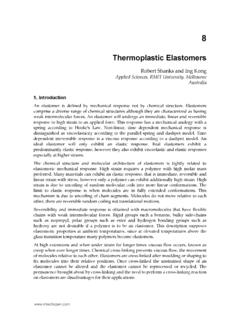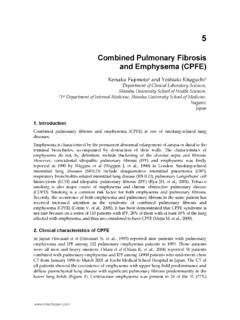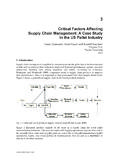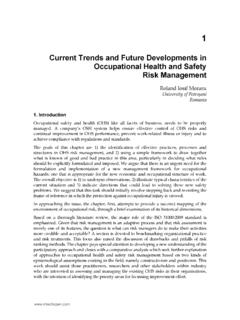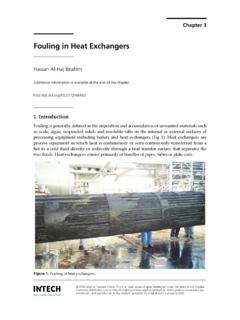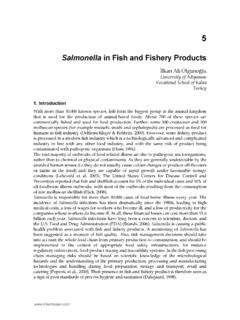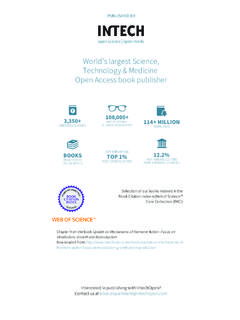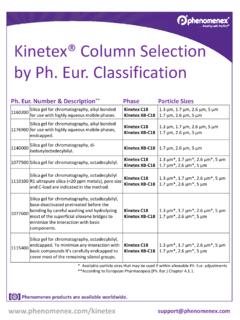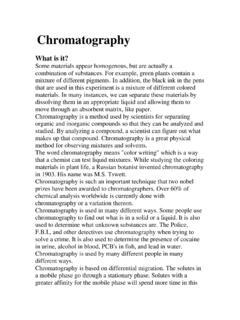Transcription of Affinity Chromatography: Principles and Applications
1 1 Affinity chromatography : Principles and Applications Sameh Magdeldin1,2 and Annette Moser3 1 Department of Structural Pathology, Institute of Nephrology, Graduate School of Medical and Dental Sciences, Niigata University, 2 Department of Physiology, Faculty of Veterinary Medicine, Suez Canal University, Ismailia, 3 Department of Chemistry, University of Nebraska at Kearney, Kearney, NE, 1 Japan 2 Egypt 3 USA 1. Introduction Since the inception of Affinity chromatography 50 years ago (Cuatrecasas et al, 1968), traditional purification techniques based on pH, ionic strength, or temperature have been replaced by this sophisticated approach. It has been stated that over 60% of all purification techniques involve Affinity chromatography (Lowe, 1996).
2 The wide applicability of this method is based on the fact that any given biomolecule that one wishes to purify usually has an inherent recognition site through which it can be bound by a natural or artificial molecule. Thus, we can say that Affinity chromatography is principally based on the molecular recognition of a target molecule by a molecule bound to a column. Affinity purification involves 3 main steps: a. Incubation of a crude sample with the Affinity support to allow the target molecule in the sample to bind to the immobilized ligand. b. Washing away non-bound sample components from the support. c. Elution (dissociation and recovery) of the target molecule from the immobilized ligand by altering the buffer conditions so that the binding interaction no longer occurs.
3 Since the beginning of this technique, the term Affinity chromatography has raised many controversies among researchers. Some say it would be more accurate if termed bioaffinity chromatography (O'Carra et al, 1974) or hydrophobic Affinity (Shaltiel, 1974). Nonetheless, the term Affinity chromatography has been expanded to describe a potential method of separating biomolecule mixtures on the basis of specific biological interactions. Recently, a modern form of liquid chromatography referred to as flash chromatography was introduced. 2. History of Affinity chromatography In 1910, the German scientist, Emil Starkenstein published an article which described the concept of resolving macromolecule complexes via their interactions with an immobilized Affinity chromatography 4 substrate.
4 This manuscript discussed the influence of chloride on the enzymatic activity of liver -amylase and opened the door for the early beginnings of this approach by several researchers (Arsenis & McCormick, 1966; Bautz & Hall, 1962; Campbell et al, 1951; Sander et al, 1966). Later on, the term Affinity chromatography introduced in 1968 by Pedro Cuatecasas, Chris Anfinsen and Meir Wilchek in an article that briefly described the technique of enzyme purification via immobilized substrates and inhibitors (Cuatrecasas et al, 1968). Other early articles described the activation of a Sepharose matrix using a cyanogen bromide (CNBr) reaction (Axen et al, 1967) and the use of a spacer arm to alleviate steric hindrance (Cuatrecasas et al, 1968).
5 Affinity chromatography is still developing. It has played a central role in many Omics technologies, such as genomics, proteomics and metabolomics. The breakthrough development of Affinity liquid chromatography has enabled researchers to explore fields such as protein protein interactions, post translational modifications and protein degradation that were not possible to be examined previously. Finally, the coupling of reversed phase Affinity chromatography with mass spectrometry has ultimately aided in discovery of protein biomarkers. 3. Fundamental Principles of Affinity chromatography Separation of a desired protein using Affinity chromatography relies on the reversible interactions between the protein to be purified and the Affinity ligand coupled to chromatographic matrix.
6 As stated earlier, most of the proteins have an inherent recognition site that can be used to select the appropriate Affinity ligand. The binding between the protein of interest and the chosen ligand must be both specific and reversible. Fig. 1. Typical Affinity chromatography purification A typical Affinity purification is shown in Figure 1 and involves several steps. First, samples are applied under conditions that favor maximum binding with the Affinity ligand. After sample application, a washing step is applied to remove unbound sustances, leaving the desired (bound) molecule still attached to the Affinity support. To release and elute the Affinity chromatography : Principles and Applications 5 bound molecules, a desorption step is usually performed either 1) specifically using a competitive ligand or 2) non-specifically by changing the media atmosphere ( changing the ionic strength, pH or polarity) (Zachariou, 2008).
7 As the elution is perfomed, the purified protein can be collected in a concentrated form. Biomolecules purified by Affinity chromatography Antibodies were first purified using Affinity chromatography in 1951 when Campbell et al. used Affinity chromatography to isolate rabbit anti-bovine serum albumin antibodies (Campbell et al, 1951). For their purification, bovine serum albumin was used as the Affinity ligand on a cellulose support. Two years later, this technique was expanded to purify mushroom tyrosinase using an immobilized inhibitor of the enzyme (azophenol) (Lerman, 1953). Since then, Affinity chromatography is commonly used to purify biomolecules such as enzymes, recombinant proteins, antibodies, and other biomolecules.
8 Affinity chromatography is often chosen to purify biomolecules due to its excellent specificity, ease of operation, yield and throughput. In addition, Affinity chromatography has the ability to remove pathogens, which is necessary if the purified biomolecules are to be used in clinical Applications . The purity and recovery of target biomolecules is controlled by the specificity and binding constant of the Affinity ligand. In general, the association constants of Affinity ligands used for biomolecule purification range from 103 108 M-1 (Janson, J-C, 1984). A common Affinity ligand used in these purifications is an antibody, but other Affinity ligands such as biomimetic dye-ligands, DNA, proteins and small peptides have been used as well.
9 Figure 2 shows a wide variety of molecules that can be purified by Affinity chromatography based on their polarity and volatility. Fig. 2. Illustration showing different molecules that can be purified using Affinity chromatography . Affinity chromatography 6 Components of Affinity medium When Affinity chromatography is used for the purification and separation of large biomolecules from complex mixtures, the support (matrix), spacer arms, and ligand must be considered. Affinity supports (matrix) Traditionally, Affinity chromatography support materials have consisted of porous support materials such as agarose, polymethacrylate, polyacrylamide, cellulose, and silica.
10 All of these support materials are commercially available and come in a range of particle and pore sizes. Some supports may be available with common Affinity ligands already immobilized ( protein A, Cibacron Blue, heparin). Other types of support materials are being developed including nonporous supports, membranes, flow-through beads (perfusion media), monolithic supports, and expanded-bed adsorbents. Nonporous support materials consist of nonporous beads with diameters of 1- 3 m. These supports allow for fast purifications, but suffer from low surface areas when compared to traditional porous supports. Membranes used in Affinity chromatography also lack diffusion pores which limits surface area, but like the nonporous beads allow for fast separations.


